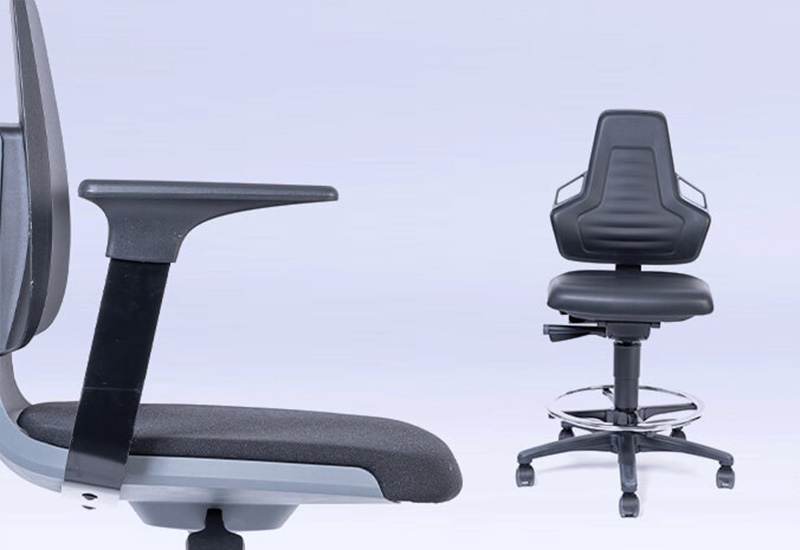
Ergonomic chairs for industry
Ergonomic chairs may not always be the right solution for every workplace. Yet ergonomics can provide the right solution for every workplace. Is that a bit confusing for you? Take a look at the different working environments with us and uncover the meaning behind both statements.
Office vs. production
The average office workplace is characterised by a clean environment and often involves relatively little movement. Employees spend most of their time sitting in their fixed positions without changing and performing the same type of movements. They keep their bodies upright when sitting or lean backwards. The height at which they work is determined by the height of the desk and changes little.
Things take a different course in production: Oils, chips, airborne sparks, lint and other contaminants surround the employees. They have a greater range of movement to reach materials, set down products or grip tools. They often adopt a forward-leaning posture while working. The working height can vary depending on the workpiece. It is common in production that employees change their workstations.
Do you recognise a few points in these descriptions as to the reasons why office chairs are not a good idea for production workplaces?
What ergonomic chairs must be able to do in industry
We have a competent partner by our side in the manufacturer BIMOS, who recognises the differences. Ergonomic chairs for industry and laboratories take centre stage with them. They have perfected their solutions over the last 50 years:
| Situation | Solution | |
|---|---|---|
| Environment | Danger of rapid contamination. Material is subjected to greater wear and tear. | Use of sturdy materials that are simple to clean. |
| Activity | Activities that vary greatly with a large range of movement. This calls for both fine motor skills and physical effort. | Compact design (e.g. due to a tapered backrest) ensures ample freedom of movement. Anti-slip materials make it safe to sit and move around on the chair. |
| Posture | More inclined towards the front. | The inclination of the seat can be adjusted. Backrest features permanent contact to ensure optimum back support at all times. |
| Working height | Varies depending on the workpiece. | Seat height can be varied considerably. Chairs can be equipped with footrests and climbing aids. |
| Who is sitting on the chair? | Shift work patterns mean that several people may use the same chair and possibly change workplaces. | Different chair functions can be adjusted easily. The upholstery can be interchanged with ease so that the chair can be customised quickly. Robust materials are designed for long-term use. |
On top of these points, there are also special requirements in the industrial and laboratory sectors. The basis for this is provided by DIN 68877-1, which specifies the dimensions for industrial chairs. Many industries also call for ESD capability. Hygiene also plays an important role when we look at laboratory environments and cleanroom conditions.
Ergonomics is important in the industry
So you see: a normal office chair can’t offer practical solutions for all points. BIMOS has made it its mission to ensure that its chairs meet the requirements of the industry. They work closely with medical and practice specialists to achieve this goal. They have developed an extensive range of ergonomic chairs for the industry over the years. What’s more, BIMOS has also developed standing aids to support users when standing and take the strain off their spine.
Let’s ask ourselves: what benefits do these ergonomic chairs and standing aids have for our everyday working lives? You are probably already familiar with one argument: sitting and standing ergonomically prevents incorrect and one-sided strain on your body. This helps prevent back pain, tension, tendonitis and similar symptoms and illnesses.
You also work with greater concentration and get tired less quickly. The chairs and standing aids take the strain off your body and keep it relaxed. You expend less energy to maintain your working position. The energy you save can be used for your work, increasing quality and productivity.
Should these two arguments not be convincing, then we can turn to the cost-benefit factor: A number of different sources estimate that one day of sick leave costs a company an average of 400 euros. This can fluctuate depending on the company. Being off work for a few days due to back pain is an expensive prospect for your company. A chair with all the extras and special accessories is significantly cheaper.
Where can you purchase ergonomic chairs and standing aids for the industry?
PCH has been a specialist dealer covering the entire BIMOS range for many years. In view of the wide range of options available, it makes good sense to consult our specialist staff in advance. Just drop us a message! We will find the perfect chair or the right standing aid for your workplace!